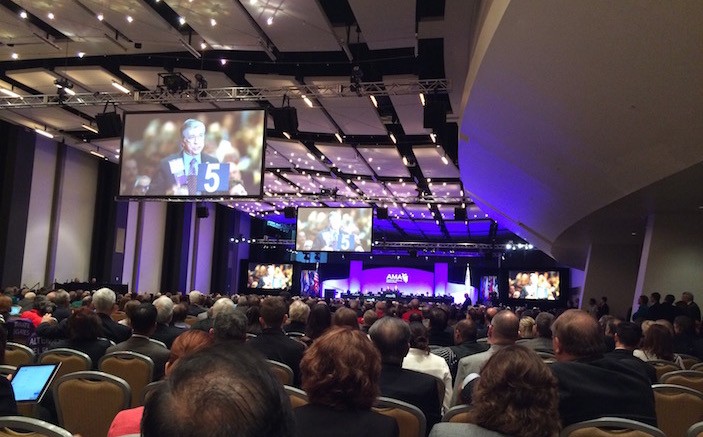A seat at the table means a feast of resolutions: from education to ethics to EHR . . . to plastic microbeads?
The AMA House of Delegates met in November in Atlanta, Georgia. All of the usual suspects were in attendance. Some were very old, some very young. Some were idealists, some were realists, and others were skeptics, but all seemed to have a passion to do what was right.
We came together to consider some 66 resolutions and some 28 reports from various councils and the Board of Trustees, including the somewhat overwhelming 365 page Code of Medical Ethics – which, by the way, governs all of us, whether we like it or not. Emergency medicine was well represented with a strong EM section.
Most of the resolutions approved had little to do with the practice of emergency medicine. The titles are self-explanatory and included: Infertility Benefits for Wounded Warriors, Burdensome Paperwork for Breast Pumps, Lymphedema Treatment Act and Plastic Microbeads in the Great Lakes.
Several of the resolutions passed had at least some relationship to the practice of emergency medicine. These included: National Drug Shortages, EHR Interoperability, Board of Trustees Report on Principles for Hospital Sponsored Electronic Health Records, Escalating Drug Costs, and Removing Disincentives and Studying the Use of Incentives to Increase the National Organ Donor Pool. As delegates, these seemed easy to support. There were also at least a couple of approved resolutions that we should all be aware of and advocate against, such as Healthcare Entity Consolidation and Health Insurance Company Consolidation, primarily because consolidation means fewer choices for physicians and consumers and also greater control for pharma and health insurance companies as they inch closer to monopoly status and behavior.
Finally, a few of the resolutions passed had direct impact on emergency medicine, some of which I’ll highlight here:
- Council on Medical Service Report on Emergency Prescription Drug Refills: This resolution advocated for allowing pharmacists to refill certain kinds of medications automatically and then to get appropriate approval later. How many patients do we see every day who simply need a prescription refill
- Study OTC Availability of Naloxone: This resolution would hopefully, if found feasible, increase the availability of Naloxone and thereby hopefully decrease the dramatic rise in opioid overdose deaths that we are seeing. It would also have the likely effect of lowering the cost.
- Model State Legislation Promoting the Use of Electronic Tools to Mitigate Risk with Prescription Opioid Prescribing: This resolution would serve to standardize the approach to Prescription Monitoring Programs and make their accessibility easier and automatic whenever a narcotic prescription is considered. Currently many of the state-mandated programs are very cumbersome and user-unfriendly to all physicians and are therefore not frequently and appropriately accessed, even when mandated. How many hours do we waste each year accessing cumbersome poorly constructed PMP’s?
- Council on Medical Education Report on Reconciliation of MOC and MOL Policies: This resolution reviewed the current and projected status of each of these categories. Additionally, several resolutions on MOC and ABMS urged the AMA to work to eliminate much of burden of MOC as currently prescribed by the ABMS. Clearly, emergency physicians everywhere have a stake in this topic.
Why would any emergency physician give up five days for these meetings and votes, many of which seem tangential to emergency medicine? Because we need to be at the table during every discussion of proposed regulations and policies and priorities of organized medicine. We need to be at those meetings to respond positively to those challenges and assumptions made about emergency medicine by those who may desire to whittle away what we have gained over these past 40 years.
So I encourage you to get involved, whether at the national or local level. Without your input and your participation and your diligence we could all again become “Just ER Docs.”
Photo by Alexis Rudd






1 Comment
Dr. Carius:
You are so right! We need to be at the table for these discussions and more. Especially needed is to show up at the State House as an individual physician and meet directly with representatives.
Less useful are the photo ops where the comments are canned and the legislators can get all we would say from a briefing handout.
90% of winning is showing up!